Exercises
Question 13.266
Use the table below to calculate the difference quotients  for h = −0.2, −0.1, 0.1, 0.2. Then estimate the velocity and speed at t = 1.
for h = −0.2, −0.1, 0.1, 0.2. Then estimate the velocity and speed at t = 1.
|
r(0.8) |
〈1.557, 2.459,-1.970〉 |
|
r(0.9) |
〈1.559, 2.634,-1.740〉 |
|
r(1) |
〈1.540, 2.841,-1.443〉 |
|
r(1.1) |
〈1.499, 3.078,-1.035〉 |
|
r(1.2) |
〈1.435, 3.342,-0.428〉 |
Question 13.267
Draw the vectors r(2 + h) − r(2) and  for h = 0.5 for the path in Figure 10. Draw v(2) (using a rough estimate for its length).
for h = 0.5 for the path in Figure 10. Draw v(2) (using a rough estimate for its length).
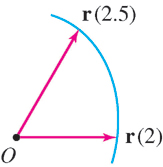
In Exercises 3–
Question 13.268

Question 13.269

Question 13.270

Question 13.271

Question 13.272
Find a(t) for a particle moving around a circle of radius 8 cm at a constant speed of υ = 4 cm/s (see Example 4). Draw the path and acceleration vector at  .
.
Question 13.273
Sketch the path r(t) = 〈1 − t2, 1 − t〉 for −2 ≤ t ≤ 2, indicating the direction of motion. Draw the velocity and acceleration vectors at t = 0 and t = 1.
Question 13.274
Sketch the path r(t) = 〈t2, t3〉 together with the velocity and acceleration vectors at t = 1.
Question 13.275
 The paths r(t) = 〈t2, t3〉 and r1(t) = 〈t4, t6〉 trace the same curve, and r1(1) = r(1). Do you expect either the velocity vectors or the acceleration vectors of these paths at t = 1 to point in the same direction? Compute these vectors and draw them on a single plot of the curve.
The paths r(t) = 〈t2, t3〉 and r1(t) = 〈t4, t6〉 trace the same curve, and r1(1) = r(1). Do you expect either the velocity vectors or the acceleration vectors of these paths at t = 1 to point in the same direction? Compute these vectors and draw them on a single plot of the curve.
In Exercises 11–
Question 13.276

Question 13.277

Question 13.278

Question 13.279

In Exercises 15–
Question 13.280

Question 13.281

Question 13.282

Question 13.283

In Exercises 19–
Question 13.284
A bullet is fired from the ground at an angle of 45°. What initial speed must the bullet have in order to hit the top of a 120-
Question 13.285
Find the initial velocity vector v0 of a projectile released with initial speed 100 m/s that reaches a maximum height of 300 m.
Question 13.286
Show that a projectile fired at an angle θ with initial speed υ0 travels a total distance  sin 2θ before hitting the ground. Conclude that the maximum distance (for a given υ0) is attained for θ = 45°.
sin 2θ before hitting the ground. Conclude that the maximum distance (for a given υ0) is attained for θ = 45°.
Question 13.287
One player throws a baseball to another player standing 25 m away with initial speed 18 m/s. Use the result of Exercise 21 to find two angles θ at which the ball can be released. Which angle gets the ball there faster?
Question 13.288
A bullet is fired at an angle  at a tower located d = 600 m away, with initial speed υ0 = 120 m/s. Find the height H at which the bullet hits the tower.
at a tower located d = 600 m away, with initial speed υ0 = 120 m/s. Find the height H at which the bullet hits the tower.
Question 13.289
Show that a bullet fired at an angle θ will hit the top of an h-meter tower located d meters away if its initial speed is

Question 13.290
A constant force F = 〈5, 2〉 (in newtons) acts on a 10-
Question 13.291
A force F = 〈24t, 16 − 8t〉 (in newtons) acts on a 4-
Question 13.292
A particle follows a path r(t) for 0 ≤ t ≤ T, beginning at the origin O. The vector  is called the average velocity vector. Suppose that
is called the average velocity vector. Suppose that  . Answer and explain the following:
. Answer and explain the following:
Where is the particle located at time T if
 ?
?Is the particle’s average speed necessarily equal to zero?
Question 13.293
At a certain moment, a moving particle has velocity v = 〈2, 2, −1〉 and a = 〈0, 4, 3〉. Find T, N, and the decomposition of a into tangential and normal components.
Question 13.294
At a certain moment, a particle moving along a path has velocity v = 〈12, 20, 20〉 and acceleration a = 〈2, 1, −3〉. Is the particle speeding up or slowing down?
764
In Exercises 30–
Question 13.295
r(t) = 〈t2, t3〉
Question 13.296
r(t) = 〈t, cos t, sin t〉
Question 13.297

Question 13.298

In Exercise 34–
Question 13.299

Question 13.300

Question 13.301

Question 13.302

Question 13.303

Question 13.304

Question 13.305

Question 13.306

Question 13.307
Let r(t) = 〈t2, 4t − 3〉. Find T(t) and N(t), and show that the decomposition of a(t) into tangential and normal components is

Question 13.308
Find the components aT and aN of the acceleration vector of a particle moving along a circular path of radius R = 100 cm with constant velocity υ0 = 5 cm/s.
Question 13.309
In the notation of Example 5, find the acceleration vector for a person seated in a car at (a) the highest point of the Ferris wheel and(b) the two points level with the center of the wheel.
Question 13.310
Suppose that the Ferris wheel in Example 5 is rotating clockwise and that the point P at angle 45° has acceleration vector a = 〈0, −50〉 m/min2 pointing down, as in Figure 11. Determine the speed and tangential acceleration of the Ferris wheel.
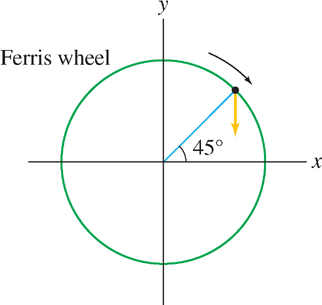
Question 13.311
At time t0, a moving particle has velocity vector v = 2i and acceleration vector a = 3i + 18k. Determine the curvature κ(t0) of the particle’s path at time t0.
Question 13.312
A space shuttle orbits the earth at an altitude 400 km above the earth’s surface, with constant speed υ = 28,000 km/h. Find the magnitude of the shuttle’s acceleration (in km/h2), assuming that the radius of the earth is 6378 km (Figure 12).
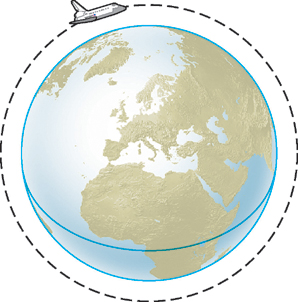
Question 13.313
A car proceeds along a circular path of radius R = 300 m centered at the origin. Starting at rest, its speed increases at a rate of t m/s2. Find the acceleration vector a at time t = 3 s and determine its decomposition into normal and tangential components.
Question 13.314
A runner runs along the helix r(t) = 〈cos t, sin t, t〉. When he is at position  , his speed is 3 m/s and he is accelerating at a rate of
, his speed is 3 m/s and he is accelerating at a rate of  . Find his acceleration vector a at this moment. Note: The runner’s acceleration vector does not coincide with the acceleration vector of r(t).
. Find his acceleration vector a at this moment. Note: The runner’s acceleration vector does not coincide with the acceleration vector of r(t).
Question 13.315
 Explain why the vector w in Figure 13 cannot be the acceleration vector of a particle moving along the circle. Hint: Consider the sign of w · N.
Explain why the vector w in Figure 13 cannot be the acceleration vector of a particle moving along the circle. Hint: Consider the sign of w · N.
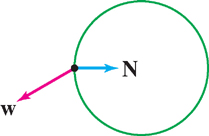
Question 13.316
 Figure 14 shows acceleration vectors of a particle moving clockwise around a circle. In each case, state whether the particle is speeding up, slowing down, or momentarily at constant speed. Explain.
Figure 14 shows acceleration vectors of a particle moving clockwise around a circle. In each case, state whether the particle is speeding up, slowing down, or momentarily at constant speed. Explain.
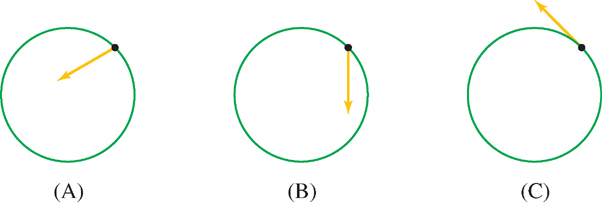
Question 13.317
Prove that  .
.
Question 13.318
Suppose that r = r(t) lies on a sphere of radius R for all t. Let J = r × r′. Show that r′ = (J × r)/∥r∥2. Hint: Observe that r and r′ are perpendicular.
765